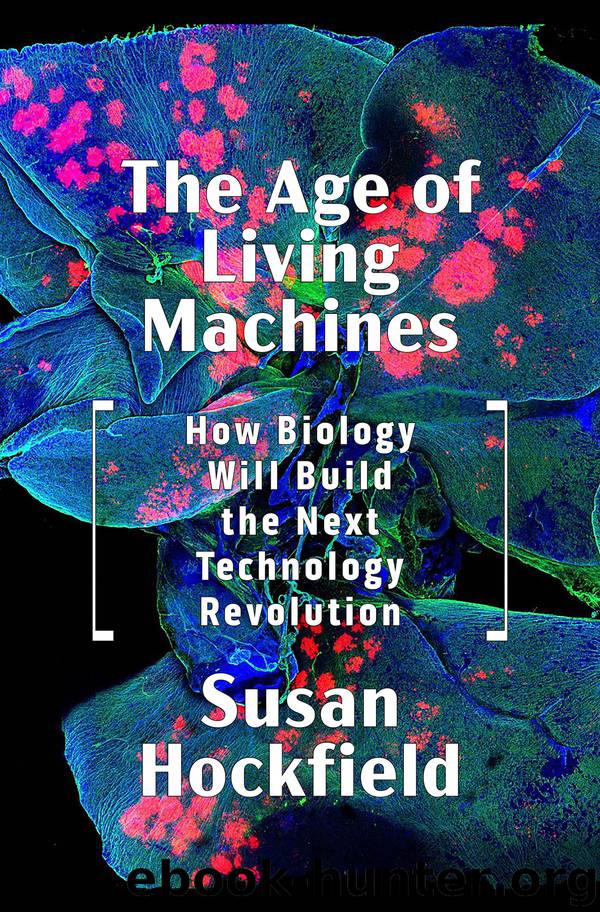The Age of Living Machines: How Biology Will Build the Next Technology Revolution by Susan Hockfield & Susan Hockfield

Author:Susan Hockfield & Susan Hockfield
Language: eng
Format: epub
Tags: Epub3
Publisher: W. W. Norton Company
Published: 2019-05-06T23:00:00+00:00
The Punnett square is the standard representation of a genetic cross. In pea plants, yellow seed color (Y) is dominant over green (y). Pea plants with either two yellow genes (YY) or with one yellow and one green gene (Yy, heterozygotes) will have yellow seeds. When two parent Yy pea plants are crossed to each other, the offspring plants that inherit either one or two dominant, yellow (Y) genes will have yellow seeds. That is, offspring that inherit two Y genes (YY, homozygotes) will have yellow seeds, as will offspring plants that inherit one yellow (Y) and one green (y) gene (Yy, heterozygotes). Only the offspring plants that inherit two copies of the recessive green gene (yy, homozygotes) will have green seeds.
Mendel’s work was poorly understood and mostly forgotten during his lifetime, but at the beginning of the twentieth century, several researchers rediscovered and replicated it and, following Johannsen, started calling Mendel’s “factors” genes. Guided by Mendel’s laws and the emerging field of genetics, agronomists began to think in new ways about how to breed plants.
Meanwhile, other researchers were gradually ramping up the hunt for the molecular structure of DNA—a hunt that had begun in 1869, when the Swiss biologist Friedrich Miescher had isolated a substance that he called “nuclein” from the cell nucleus of blood cells. Miescher didn’t know it, but he had identified the physical substrate of heredity. In fact, for decades most scientists believed that nuclein couldn’t possibly carry genetic information because its structure was too repetitive and boring. The rich diversity of observed phenotypes, they reasoned, should require an equally diverse material, and so nuclein’s relevance to heredity was largely dismissed.
The hunt for the substance of heredity continued for decades, until 1953, when in one of the most famous papers ever published, James Watson and Francis Crick proposed the double helix as a model for the molecular structure of DNA. As we saw in chapter 2, the double helix that they described resembled a twisting ladder with parallel phosphate-sugar chains interconnected by rungs composed of pairs of the four bases that always pair in the same pattern (guanine with cytosine and adenine with thymine), thereby mediating DNA’s accurate replication.
With the description of the structure of DNA, the field of molecular biology truly came into its own. Now that biologists understood its basic structure, they were soon able to determine that genetic information is first copied from DNA into RNA (very similar in structure to a single strand of DNA) and then translated from RNA into proteins. The proteins then guide the assembly of cells into tissues and give rise to many of the emergent properties of tissues and whole organisms.
It was a landmark moment in the history of science and agriculture. After Watson and Crick’s discovery, molecular biologists deployed their new understanding of genetics to imagine entirely new approaches to growing food. By 1983, scientists established methods for transferring DNA into plant cells as well as genetically engineering insect-resistant tobacco. All sorts of advances now became possible.
Download
This site does not store any files on its server. We only index and link to content provided by other sites. Please contact the content providers to delete copyright contents if any and email us, we'll remove relevant links or contents immediately.
| Concrete | Extraction & Processing |
| Fracture Mechanics | Materials Science |
| Metallurgy | Polymers & Textiles |
| Strength of Materials | Testing |
Whiskies Galore by Ian Buxton(41722)
Introduction to Aircraft Design (Cambridge Aerospace Series) by John P. Fielding(33019)
Small Unmanned Fixed-wing Aircraft Design by Andrew J. Keane Andras Sobester James P. Scanlan & András Sóbester & James P. Scanlan(32687)
Craft Beer for the Homebrewer by Michael Agnew(18084)
Turbulence by E. J. Noyes(7898)
The Complete Stick Figure Physics Tutorials by Allen Sarah(7269)
Kaplan MCAT General Chemistry Review by Kaplan(6825)
The Thirst by Nesbo Jo(6765)
Bad Blood by John Carreyrou(6479)
Modelling of Convective Heat and Mass Transfer in Rotating Flows by Igor V. Shevchuk(6356)
Learning SQL by Alan Beaulieu(6162)
Weapons of Math Destruction by Cathy O'Neil(6087)
Man-made Catastrophes and Risk Information Concealment by Dmitry Chernov & Didier Sornette(5880)
Digital Minimalism by Cal Newport;(5590)
Life 3.0: Being Human in the Age of Artificial Intelligence by Tegmark Max(5407)
iGen by Jean M. Twenge(5330)
Secrets of Antigravity Propulsion: Tesla, UFOs, and Classified Aerospace Technology by Ph.D. Paul A. Laviolette(5241)
Design of Trajectory Optimization Approach for Space Maneuver Vehicle Skip Entry Problems by Runqi Chai & Al Savvaris & Antonios Tsourdos & Senchun Chai(4959)
Electronic Devices & Circuits by Jacob Millman & Christos C. Halkias(4869)
